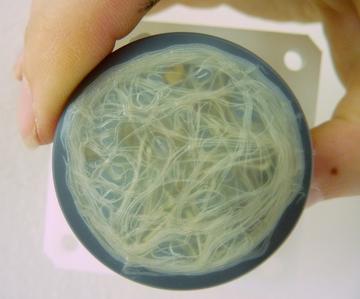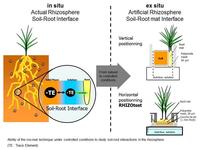Principle : the root mat technique
The root mat technique, which was first published in 1972 [1], was developed in the 1980s to study processes in the rhizosphere [2].
The technique consists in separating roots from soil using a polyamide mesh with a pore diameter smaller than that of the finest roots (i.e. a few dozen micrometres). As they grow, plants develop a root system in the form of a planar mat against the surface of the polyamide mesh. The contact between the root mat and the soil is enough to maintain exchanges of water, nutrients and various molecules, so that this soil-root mat interface makes it possible, to some degree, to reproduce the interactions that take place at the soil-root interface, i.e. in the rhizosphere.
When this growing technique is used in a controlled environment (growth chamber), it offers the advantage of enabling the simple, rapid and separate harvesting of:
- soil affected by root activities, i.e. the rhizosphere,
- whole plants, and in particular the whole root system, with little or no contamination by soil particles.
However, the root mat technique also has a certain number of limitations:
- a planar geometry that differs from the cylindrical geometry of roots and which tends to overestimate the extent of rhizosphere processes,
- an average root effect that does not take into account the heterogeneity of soil-root interactions at finer observation levels (e.g. primary roots versus secondary roots, apex versus piliferous zone, etc.)
1. Hsieh JJC, Gardner WH et Campbell GS 1972 Experimental Control of Soil Water Content in the Vicinity of Root Hairs. Soil Sci. Soc. Am. Proc., 144, 486-499.
2. Kuchenbuch R et Jungk A 1982 A method for determining concentration profiles at the soil-root interface by thin slicing rhizospheric soil. Plant Soil, 68, 391-394.


